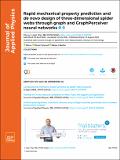| dc.contributor.author | Lu, Wei | |
| dc.contributor.author | Yang, Zhenze | |
| dc.contributor.author | Buehler, Markus J. | |
| dc.date.accessioned | 2022-09-19T18:05:25Z | |
| dc.date.available | 2022-09-19T18:05:25Z | |
| dc.date.issued | 2022-08-21 | |
| dc.identifier.issn | 0021-8979 | |
| dc.identifier.issn | 1089-7550 | |
| dc.identifier.uri | https://hdl.handle.net/1721.1/145503 | |
| dc.description.abstract | <jats:p> Spider webs feature advanced structural performance due to the evolutionary success of over more than 3 × 10<jats:sup>9</jats:sup> years, including lightweight design and exceptional mechanical properties. Spider webs are appealing for bio-inspired design since web designs serve multiple functions including mechanical protection and prey catching. However, high computational cost and limited quantified web properties render extensive spider web studies challenging in part due to the high structural complexity and randomness of fiber arrangements in 3D webs. Here, we report a computational method to relate spider web graph microstructures to effective mechanical properties, focusing on strength and toughness, and upscaling from the microscopic to the mesoscale level. The new computational framework uses deep neural networks, trained on graph-structured Cyrtophora citricola spider web mechanical data, in order to capture complex cross-scale structural relationships. Three different models are developed and compared. First, two Graph Neural Network (GNN) models, a Graph Convolutional Network, and a Principal Neighborhood Aggregation method. Second, a GraphPerceiver transformer model that is fed similar input data as provided to the GNN approach but within a natural language modeling context using self-attention mechanisms. The GraphPerceiver model can achieve similar performance as the GNN model, offering added flexibility for building deep learning models of diverse hierarchical biological materials. As an application of the model, we propose a computational optimization tool for synthetic web design that is used to generate synthetic, de novo spider web architectures. Finally, multi-objective optimization enables us to discover web structures that meet specific mechanical properties as design objectives. </jats:p> | en_US |
| dc.publisher | AIP Publishing | en_US |
| dc.relation.isversionof | 10.1063/5.0097589 | en_US |
| dc.rights | Creative Commons Attribution 4.0 International license | en_US |
| dc.rights.uri | https://creativecommons.org/licenses/by/4.0/ | en_US |
| dc.source | American Institute of Physics (AIP) | en_US |
| dc.title | Rapid mechanical property prediction and <i>de novo</i> design of three-dimensional spider webs through graph and GraphPerceiver neural networks | en_US |
| dc.type | Article | en_US |
| dc.identifier.citation | Lu, Wei, Yang, Zhenze and Buehler, Markus J. 2022. "Rapid mechanical property prediction and <i>de novo</i> design of three-dimensional spider webs through graph and GraphPerceiver neural networks." 132 (7). | |
| dc.contributor.department | Massachusetts Institute of Technology. Department of Civil and Environmental Engineering | en_US |
| dc.contributor.department | Massachusetts Institute of Technology. Department of Materials Science and Engineering | en_US |
| dc.contributor.department | Massachusetts Institute of Technology. Department of Mechanical Engineering | en_US |
| dc.contributor.department | Massachusetts Institute of Technology. Laboratory for Atomistic and Molecular Mechanics | en_US |
| dc.eprint.version | Final published version | en_US |
| dc.type.uri | http://purl.org/eprint/type/JournalArticle | en_US |
| eprint.status | http://purl.org/eprint/status/PeerReviewed | en_US |
| dspace.date.submission | 2022-09-19T17:51:48Z | |
| mit.journal.volume | 132 | en_US |
| mit.journal.issue | 7 | en_US |
| mit.license | PUBLISHER_CC | |
| mit.metadata.status | Authority Work and Publication Information Needed | en_US |
